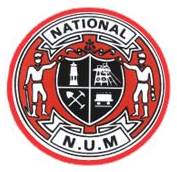Related Research Articles
The miners' strike of 1984-85 was a major industrial action to shut down the British coal industry in an attempt to prevent colliery closures. It was led by Arthur Scargill of the National Union of Mineworkers (NUM) against the National Coal Board (NCB), a government agency. Opposition to the strike was led by the Conservative government of Prime Minister Margaret Thatcher, who wanted to reduce the power of the trade unions.

The National Union of Mineworkers (NUM) is a trade union for coal miners in Great Britain, formed in 1945 from the Miners' Federation of Great Britain (MFGB). The NUM took part in three national miners' strikes, in 1972, 1974 and 1984–85. After the 1984–85 strike and the subsequent closure of most of Britain's coal mines, it became a much smaller union. It had around 170,000 members when Arthur Scargill became leader in 1981, a figure which had fallen in 2015 to an active membership of around 100.
The Union of Democratic Mineworkers (UDM) is a British trade union for coal miners based in Nottinghamshire, England. Established in 1985 after a constitutional crisis in the National Union of Mineworkers, the UDM was given its certification on 6 December 1985, although it had effectively been in existence since the Nottinghamshire area of the NUM voted to secede from the federal union on 6 July 1985. After the events of the strike in 1984-5, the Nottinghamshire area of the NUM was involved in a number of disputes with the National Executive Committee that led to a ballot in May on empowering the Nottingham Area Committee to disassociate from the NUM. In ballots on 18 and 19 October on joining with Nottinghamshire in a new union, the South Derbyshire area of the NUM voted in favour by 51% and the Colliery Workers and Allied Trades Association voted in favour by almost 100%.
The Miners' Federation of Great Britain (MFGB) was established after a meeting of local mining trade unions in Newport, Wales in 1888. The federation was formed to represent and co-ordinate the affairs of local and regional miners' unions in England, Scotland and Wales whose associations remained largely autonomous. At its peak, the federation represented nearly one million workers. It was reorganised into the National Union of Mineworkers in 1945.

The Sheffield Trades and Labour Council, usually known as the Sheffield Trades Council, is a labour organisation uniting trade unionists in Sheffield.

The National Union of Scottish Mineworkers (NUSW) is a trade union in Scotland, founded in 1894 as the Scottish Miners Federation. It joined the Miners' Federation of Great Britain, and in 1914 changed its name to National Union of Scottish Mineworkers. It survives as the National Union of Mineworkers.

The Nottinghamshire Miners' Association was a trade union representing coal miners in Nottinghamshire, in England.

William Edwin Harvey, known as W. E. Harvey, was a British Lib-Lab Member of Parliament.
The Amalgamated Association of Miners (AAM) was formed in 1869 in Lancashire, at a time of increasing industrial conflict in the British coalfields.
William Bailey was a Britis trade unionist.
The South Yorkshire Miners' Association (SYMA) was an early British trade union representing coal miners in the southern West Riding of Yorkshire and northern Derbyshire.
Henry Jarvis was a British trade unionist.
The London builders' strike of 1859 was a strike and resulting lock out of building trade workers across London. The action did not result in any changes to working conditions, but it led to the formation of new, national trade unions in the United Kingdom.
The Miners' National Union (MNU) was a trade union which represented miners in Great Britain.
Peter Shorrocks was an early British trade union leader.
John Normansell was a British trade unionist.
The West Yorkshire Miners' Association (WYMA) was an early British trade union representing coal miners in the central part of the West Riding of Yorkshire.
William Brown was a British coal miner who became a prominent trade unionist.
The National Federation of Colliery Enginemen and Boiler Firemen was a union federation in the United Kingdom. Its membership changed over time, but was centred on unions representing enginemen at coal mines.
The Notts Trades Council, formally known as the Nottinghamshire Nottingham and Mansfield Trades Council, brings together trade unionists in Nottinghamshire, in England.